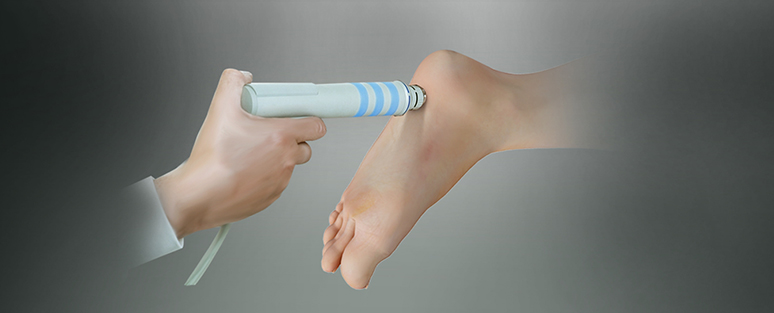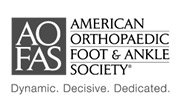Conditions
Ankle Sprain
A sprain is the stretching or tearing of ligaments, which connect adjacent bones and provide stability to a joint. An ankle sprain is a common injury that occurs when you suddenly fall or twist the joint or when you land your foot in an awkward position after a jump. Most commonly it occurs when you participate in sports or when you jump or run on a surface that is irregular.
For more information about Ankle Sprain, click on below tabs.
Achilles Tendon Rupture
Achilles tendon is a strong fibrous cord present behind the ankle that connects the calf muscles to the heel bone. It is used when you walk, run and jump. The Achilles tendon ruptures most often in athletes participating in sports that involve running, pivoting and jumping.
For more information about Achilles Tendon Rupture, click on below tab.
Plantar Fasciitis
Plantar fasciitis refers to inflammation of the plantar fascia, a thick band of tissue that lies at the bottom of the foot. It runs from the heel bone to the toe and forms the arch of your foot. Plantar fasciitis is one of the most common causes of heel pain.
For more information about Plantar Fasciitis, click on below tabs.
Ankle Fractures
The ankle joint is composed of three bones: the tibia, fibula, and talus which are articulated together. The ends of the fibula and tibia (lower leg bones) form the inner and outer malleolus, which are the bony protrusions of the ankle joint that you can feel and see on either side of the ankle.
For more information about Ankle Fractures, click on below tabs.
Ankle Instability
Ankle instability is a chronic condition characterized by a recurrent slipping of the outer side of the ankle. It usually results from repeated ankle sprains. It is generally noticed during movement of the ankle joint but can also occur during standing as well.
For more information about Ankle Instability, click on below tabs.
Nail Bed Injuries
The nail is composed of a nail plate, nail matrix and nail bed. The nail bed is the soft tissue that lies below the nail and is essential for the growth of the nail. Nail bed injuries such as crush and avulsion injuries are commonly associated with injuries to the hands or fingertips.
For more information about Nail Bed Injuries, click on below tab.
Osteochondral Injuries of the Ankle
The ankle joint is an articulation of the end of the tibia and fibula (shin bones) with the talus (heel bone). Osteochondral injuries, also called osteochondritis dissecans, are injuries to the talus bone, characterized by damage to the bone as well as the cartilage covering it.
For more information about Osteochondral Injuries of the Ankle, click on below tab.
Stress Fracture of the Foot
A stress fracture is described as a small crack in the bone which occurs from an overuse injury of a bone. It commonly develops in the weight bearing bones of the lower leg and foot. When the muscles of the foot are overworked, or stressed, they are unable to absorb the stress and when this happens the muscles transfer the stress to the bone which results in stress fracture.
For more information about Stress Fracture of the Foot, click on below tab.
Shin Splints
Shin splints or medial tibial stress syndrome (MTSS) is pain around the tibia or shin bone due to inflammation of the tendons, muscles and bone tissue. It occurs because of vigorous physical activity such as with exercise or sports.
For more information about Shin Splints, click on below tab.
Heel Fractures
The calcaneus or heel bone is a large bone found at the rear of the foot. A fracture is a break in a bone from trauma or various disease conditions. The types of fracture to the calcaneus depend on the severity and include stable fractures, displaced fractures, open fractures, closed fractures and comminuted fractures.
For more information about Heel Fractures, click on below tab.
Lisfranc (Midfoot) Fracture
The Lisfranc joint or tarsometatarsal joint refers to the region in the middle of the foot. It is a junction between the tarsal bones (seven bones in the foot arch) and metatarsal bones (five long bones in the foot). Lisfranc fracture scan occur due to a fall from a height or traumatic motor accidents.
For more information about Lisfranc (Midfoot) Fracture, click on below tab.
Talus Fractures
The talus forms part of the ankle joint. It also connects leg to the foot, enabling the up and down movement of the foot. Fractures in the talus bone may occur due to a fall from great heights, motor vehicle accidents or sports injuries. Symptoms include severe ankle pain, inability to walk, swelling and tenderness.
For more information about Talus Fractures, click on below tab.
Toe and Forefoot Fractures
The forefoot is the front of the foot that includes the toes. Fractures occurring in this part of the foot are painful, but very often not disabling. There are 2 types of fractures namely, traumatic fracture and stress fracture.
For more information about Toe and Forefoot Fractures, click on below tab.
Turf Toe
Turf toe is an injury to the ligament at the base of the big toe. It is a painful condition which usually results from jamming of the toe into the ground or excessive backward bending of the toe.
For more information about Turf Toe, click on below tab.
Foot Fracture
The foot has 26 bones, and can be divided into 3 parts: The hind foot is comprised of two bones, the talus bone which connects to the bones of the lower leg, and the calcaneus bone which forms the heel.
For more information about Foot Fracture, click on below tabs.
Foot and Ankle Trauma
The foot and ankle in the human body work together to provide balance, stability, movement, and propulsion.
For more information about Foot and Ankle Trauma, click on below tab.
Ankle Ligament Injury
Ankle ligament injury, also known as ankle sprain, can be caused by a sudden twisting movement of the foot during any athletic event or during daily activities. It is one of the most common orthopaedic injuries and can also be caused by walking down a slope or over any uneven surface.
For more information about Ankle Ligament Injury, click on below tab.
Ankle Injury
Osteochondral injuries are one of the most common causes of ankle pain. Though in most cases there is a history of injury or trauma to the ankle joint, a few cases may not have any previous history of ankle injury.
For more information about Ankle Injury, click on below tab.
Foot and Ankle Osteoarthritis
Arthritis is inflammation resulting from the degeneration of cartilage in the joint causing pain, swelling, and stiffness in the joints resulting in restricted movements. Arthritis of the foot and ankle joint can occur due to fracture, dislocation, inflammatory disease, or congenital deformity.
For more information about Foot and Ankle Osteoarthritis, click on below tab.
Achilles Tendon Bursitis
Achilles tendon bursitis or retrocalcaneal bursitis is a condition that commonly occurs in athletes. It is a painful condition caused by swelling of bursa, a fluid-filled sac which is located at the back of the heel under the Achilles tendon.
For more information about Achilles Tendon Bursitis, click on below tab.
Bunion
A bunion is a bony protuberance that appears on the external surface of the big toe when it angles toward the adjacent toe. It is an extra bone and a fluid-filled sac that grows at the base of the big toe.
For more information about Bunion, click on below tabs.
Athlete's Foot
Athlete's foot also known as tinea pedis, is a fungal infection on the skin of the foot. It is characterized by itchy, moist, white, scaly lesions between the toes that can spread to the sole of the foot.
For more information about Athlete's Foot, click on below tab.
Forefoot Pain
Forefoot pain, also referred to as metatarsalgia, is a type of pain that occurs in the ball of the foot (around the tip of the metatarsal bones). Generally, forefoot pain is associated with aging.
For more information about Forefoot Pain, click on below tab.
Intoeing
In toeing also called “pigeon-toed”, is an abnormal condition characterized by inward facing of the toe or feet instead of being straight. Parents may observe their children having intoeing at an early age when they start walking.
For more information about Intoeing, click on below tab.
Morton's Neuroma
Morton’s neuroma refers to a nerve injury between the toes, usually the third and fourth toes, which causes pain and thickening of the nerve tissue. Compression or chronic irritation of this interdigital nerve is the main cause of Morton’s Neuroma.
For more information about Morton's Neuroma, click on below tab.
Foot Pain
Foot pain occurs from distress induced by certain factors in the foot. Foot pain is a common problem experienced by young athletes involved in different activities such as running and jumping.
For more information about Foot Pain, click on below tab.
Flatfoot
Flatfoot, also known as “fallen arches” or Pes planus, is a deformity in children’s feet in which the arch that runs lengthwise along the sole of the foot has collapsed to the ground or not formed at all. Flatfoot is normal in the first few years of life as the arch of the foot usually develops between the age of 3 and 5 years.
For more information about Flatfoot, click on below tab.
Foot Infections
Foot infections may occur after trauma to the foot or loss of tissue because of contamination from foreign material and/or bacteria or fungus. Infections can occur in healthy individuals as well as in those whose health is compromised.
For more information about Foot Infections, click on below tab.
Foot Drop
Foot drop also known as drop foot, is a sign of an underlying muscular, neurological or anatomical condition, where you are unable to lift the front part of your foot, resulting in foot dragging.
For more information about Foot Drop, click on below tab.
Hammertoe
A hammertoe is a deformity of a lesser toe (second through fifth toes), where the toe gets bent upward at the toe’s middle joint, resembling a hammer. The bent portion may rub against a shoe causing pain, irritation and development of corns.
For more information about Hammertoe, click on below tab.
Mallet Toe
Mallet finger is a condition where the end of the finger is bent and does not straighten. It occurs when the extensor tendon on the back of the finger is damaged. The finger joint is a hinge-joint that allows bending and straightening of the fingers.
For more information about Mallet Toe, click on below tab.
Claw Toe
Claw toe is a deformity, where a toe bends and appears like a bird’s claw. The affected toe is bent upward from the joint at the ball of foot, and downward at the joints in the middle and tip of the toe to curl under the foot. Hard thick skin called corns may develop under the ball of the foot or on the top of the affected toe, causing pain while walking.
For more information about Claw Toe, click on below tab.
Limb Deformities
Limb deformities can be congenital (present at birth) or develop at a later stage because of fracture, infection, arthritis or tumour. Congenital deformities of the lower limbs are developmental disorders that cause alterations in the shape and appearance of the legs.
For more information about Limb Deformities, click on below tab.
Club foot and Congenital Deformity
Congenital deformities of the lower limbs are developmental disorders that are present at birth, causing alterations in the shape and appearance of the legs. Several factors such as genetics, teratogenic drugs and chemicals can cause congenital deformities.
For more information about Club foot and Congenital Deformity, click on below tab.
Ingrown toenail
An ingrown toenail is a common and painful condition of the toe. It occurs when the sides or corner of the nail grow inwards and penetrates the skin of the toe. Pain is often accompanied by swelling and redness.
For more information about Ingrown toenail, click on below tab.
Corns
A corn is a circular area of thickened skin developed because of continuous friction or pressure. They usually develop on the soles of feet, or on the top or sides of toes, and appear as yellowish dead tissue surrounding an area of tenderness.
For more information about Corns, click on below tab.
Heel Pain
The heel is made up of the calcaneus bone and supported by a network of muscles, tendons, ligaments and soft tissues, which together support the weight of the body and stress during movement.
For more information about Heel Pain, click on below tab.












